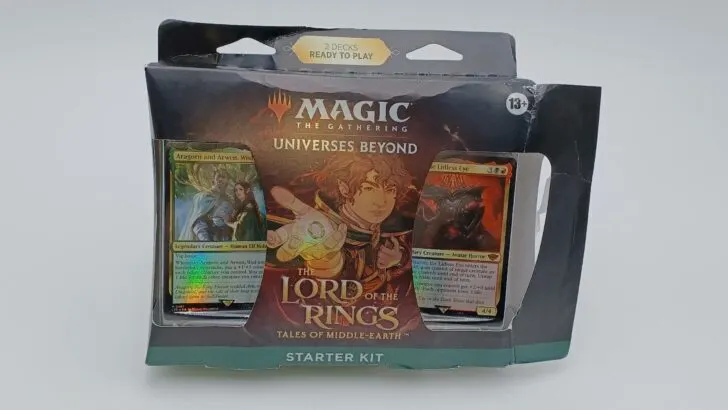Magic: The Gathering The Lord of the Rings Tales of Middle-Earth How to Play Quick Links: | Objective | Setup | Play Area | Card Layout | Playing the Game | Beginning Phase | Tapping and Untapping | First Main Phase | Combat Phase | Second Main Phase | Ending Phase | Winning the Game | FAQ | Components |
Objective of Magic: The Gathering The Lord of the Rings Tales of Middle-Earth
The objective of Magic: The Gathering The Lord of the Rings Tales of Middle-Earth is to defeat your opponent by either reducing their life to zero or depleting their library (deck of cards).
Setup for Magic: The Gathering The Lord of the Rings Tales of Middle-Earth
Each player chooses a deck to play with. You will shuffle all of the cards from your chosen deck.
Randomly choose which player will go first.
Both players need a way to track their current life total. Each player starts their life total at 20 life. One common way you can keep track of your life total is using a 20 sided die.
Each player draws seven cards from their deck. For your first game you should check to see if you drew at least two land cards. If you didn’t, you will shuffle your hand back into your deck and draw seven new cards.
If it is not your first game, you can choose to mulligan if you don’t like your hand. When you choose to mulligan you will take all of the cards from your hand and shuffle them back into your deck. You will then draw seven new cards. If you like your new hand you will keep it. If you don’t like your new hand, you can mulligan again. You can mulligan as many times as you want. When you decide to keep your hand, you will choose a number of cards from your hand equal to the number of times you choose to mulligan, and add them to the bottom of your library.
Once both players have decided to keep their hands, each player places their deck face down on the table. These cards form your library.
Play Area in Magic: The Gathering The Lord of the Rings Tales of Middle-Earth
As you start playing Magic: The Gathering The Lord of the Rings Tales of Middle-Earth you will create a play area for your cards and your opponent’s cards. The play area consists of a few different zones.
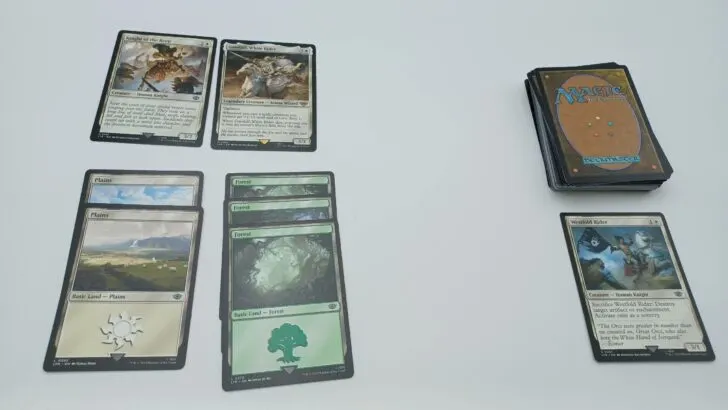
The Library
Each player has their own library. Your library is basically your own personal draw pile. You will always place your library face down to the side of the play area. If you should ever run out of cards in your library and you need to draw another card, you lose the game.
You may not look at the cards in your library except when you are drawing a card(s) or when a card directs you to.
In the picture above the library is the face down cards in the top right corner.
Hand
The cards you hold in your hand are naturally referred to as your hand. You can always look at the cards in your hand, but you shouldn’t show them to your opponent.
The max number of cards that you can hold in your hand at one time is seven. If you have more than seven cards in your hand at the end of your turn, you must discard cards until you only have seven cards remaining.
Battlefield
The battlefield takes up the middle of the play area. Both players share the battlefield with each player playing cards to their side.
During the game you will play lands, creatures, artifacts and enchantments to the battlefield. These cards are called permanents. They stay in place until they are defeated or removed from the battlefield in some other way. You can arrange your permanents in any way you want. It is recommended that you place your lands close to you. Your opponent must be able to see at all times all of the cards that you have played to the battlefield.
You will never play instant and sorcery cards to the battlefield.
The picture above shows one player’s half of the battlefield. The Knight of the Keep, Gandalf White Rider and all of the Plains and Forest cards are in the battlefield.
Graveyard
Your graveyards acts as your discard pile. Each player has their own graveyard. Throughout the game you will place your defeated creatures into the graveyard. You will also place used sorceries and instants, destroyed artifacts and enchantments, and other cards that you choose to discard. Cards placed in your graveyard are always face up. You and your opponents may look at them at any time.
In the picture above the Westfold Rider card is in the graveyard.
Anatomy of a Magic: The Gathering The Lord of the Rings Tales of Middle-Earth Card
Each card in Magic: The Gathering The Lord of the Rings Tales of Middle-Earth has certain information printed on it that tells you how it will be used. Each card in the game has the following sections:
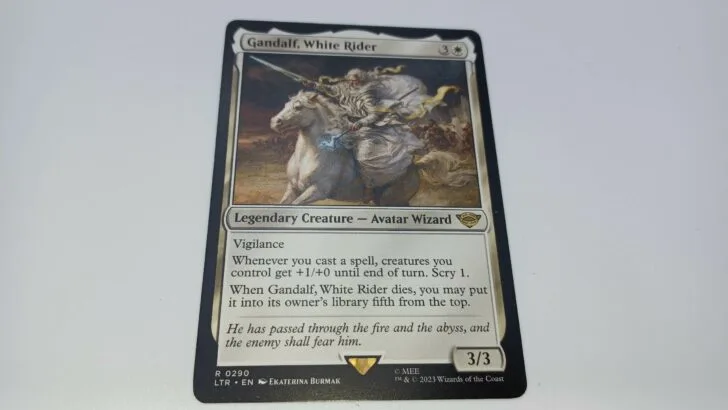
Name
The name is the identifier for the card. Each card that shares the same name is identical. You usually may only have four cards with the same name in your deck. The one exception to this is basic lands as there is no limit to how many of these cards you may have in your deck.
The name of the card pictured above is Gandalf, White Rider.
Mana Cost
The mana cost is displayed in the top right corner of each card. This is how much mana you need to spend in order to play the card. The number in the gray circle can be paid with any type of mana. Any other symbols after the gray circle have to be paid with mana of the corresponding type.
To play Gandalf, White Rider you need to use three mana of any color and one white/plains mana.
Type
Printed below the picture is the card’s type, subtype and supertype. These types indicate what type of card it is and how you can use it in the game.
From the card pictured above, Gandalf, White riders type is Legendary Creature – Avatar Wizard.
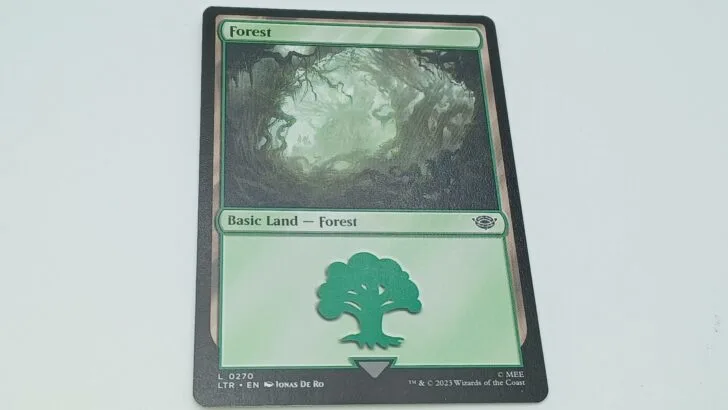
Lands
Land cards create mana each turn. Each type of land makes its own type of mana as follows:
- Plains – white
- Islands – blue
- Swamps – black
- Mountains – red
- Forests – green
To play a land card you will play it vertically to your side of the battlefield.
Once you play a land card, it will generate its mana each turn. To use the mana you need to tap the land card.
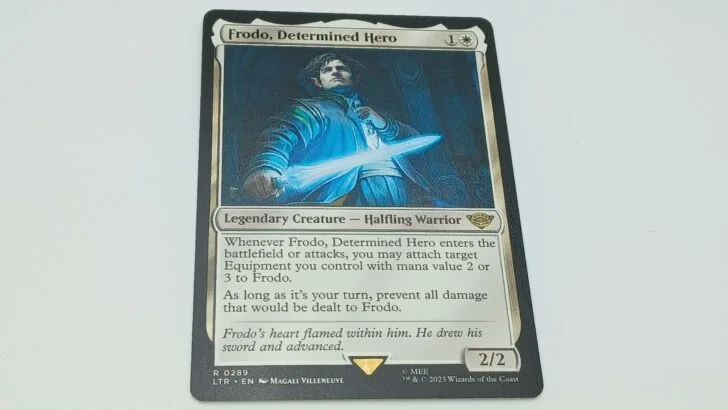
Creatures
Creatures will fight and defend. You can use creatures to attack during your combat phase, or defend during your opponent’s combat phase.
You will play a creature card during the main phase of your turn. To play the card you need to pay the corresponding mana cost. You will play the creature card to your side of the battlefield.
Creature cards cannot attack on the turn that you play them. You also can’t use their ability if it requires you to tap the card (a curved arrow symbol). You can use the creature to block on your opponent’s next turn though.
A creature card stays in the battlefield until it is destroyed, sacrificed, exiled, or removed in some other way.
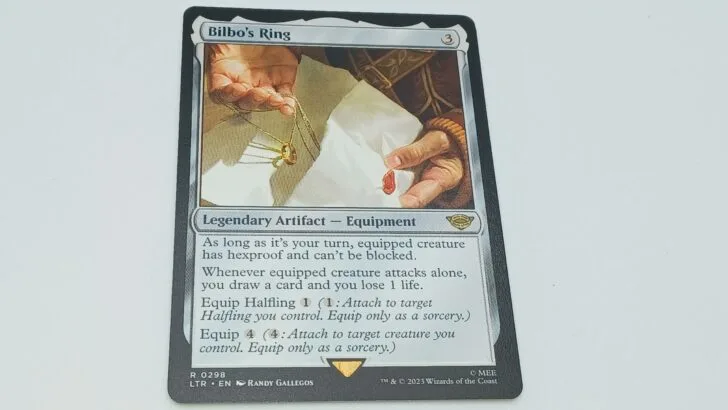
Artifacts
You will play artifact cards during your main phase. You will play the artifact to the battlefield. It stays in place until in it destroyed, sacrificed, exiled, or removed in some other way.
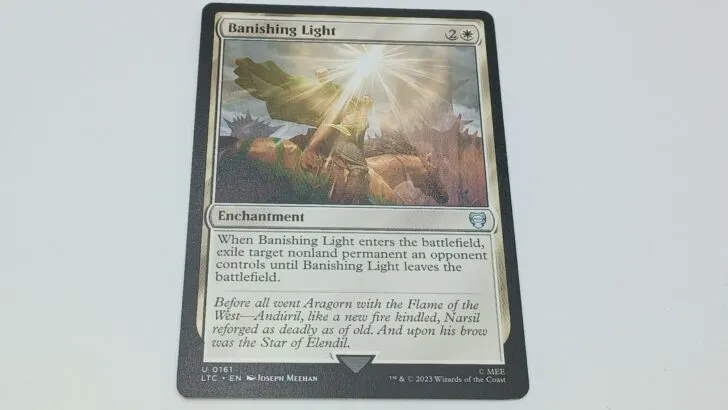
Enchantments
You will play enchantments during your main phase. They will provide you with an effect as long as they are on the battlefield.
They will remain on the battlefield until they are either destroyed, sacrificed, exiled or removed in some other way.
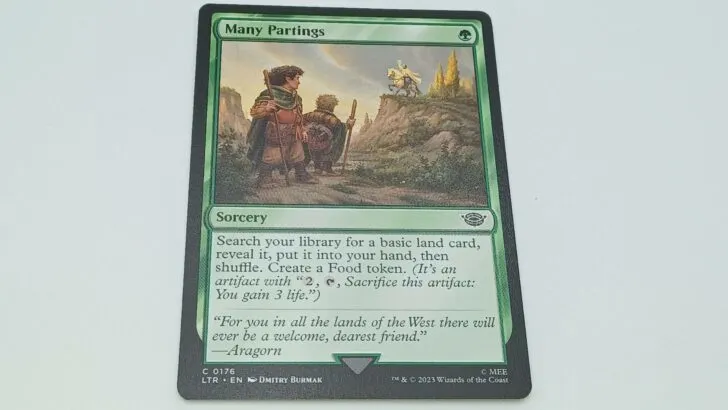
Sorcery
When you pay the mana cost to play a sorcery, you will take the corresponding effect. After you follow the instructions on the card, you will place the card in your graveyard.
You may only play sorcery cards during your main phase.
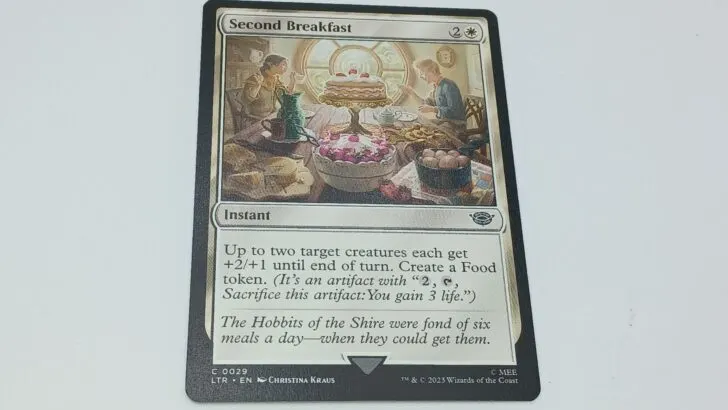
Instants
To play an instant card you need to pay its mana cost. You will then immediately follow the text printed on the card.
You can play instants at any time including during your opponent’s turn.
Text Box
Below the card’s type is a text box. In the top section of the text box is the card’s special effects. Some cards have clarification text to further explain what the card does.
Along the bottom of the text box is flavor text. This is below a horizontal line. The flavor text just describes the card and its backstory. It has no effect on gameplay.
For Gandalf’s card the text box includes all of the text starting with Vigilance and ending with the last line before the bottom of the card. All of the text before “He has passed…” details what the card does. The last line in the text box is flavor text and has no impact on what the card does in the game.
Power/Toughness
In the bottom right corner of each card is its power and toughness.
The number before the / symbol is the card’s power. A card’s power is how much damage it does in combat.
The number after the / symbol is the card’s toughness. This is how much damage has to be done to the card in a single turn before it is destroyed.
Gandalf’s card pictured above has a power of three and a toughness of three.
Playing Magic: The Gathering The Lord of the Rings Tales of Middle-Earth
Each turn in Magic: The Gathering The Lord of the Rings Tales of Middle-Earth consists of a few different phases.
- Beginning Phase
- First Main Phase
- Combat Phase
- Second Main Phase
- Ending Phase
Beginning Phase
You will begin the Beginning Phase by untapping any cards that you tapped on your last turn. See the Tapping and Untapping section below for more details.
You will then look at any cards that you have played to the battlefield. Any cards that have a “at the beginning of your upkeep” ability are triggered at this time. You will take the corresponding actions.
At the end of the Beginning Phase you will draw the top card from your library. This is mandatory. The first player does not draw a card on their first turn.
Tapping and Untapping in Magic: The Gathering The Lord of the Rings Tales of Middle-Earth
Every permanent card that you play to the battlefield will be in one of two states.
Cards that are untapped can still be used during the current turn. You will place untapped cards vertical to show that you can still use them.
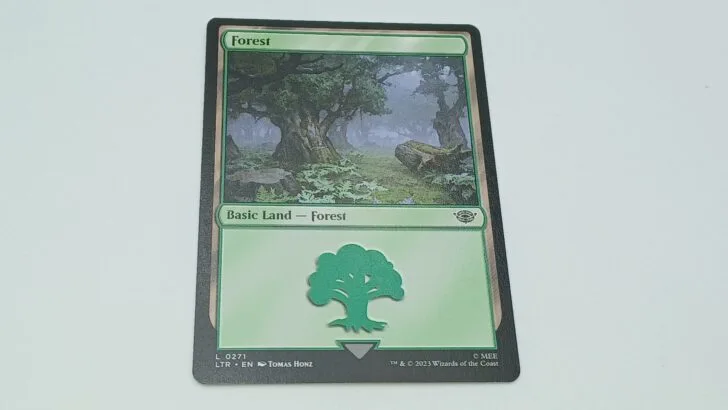
To use most permanent cards you need to tap them. When you tap a card you will turn it sideways. This is done to show the players that the card can’t be used again until your next turn.
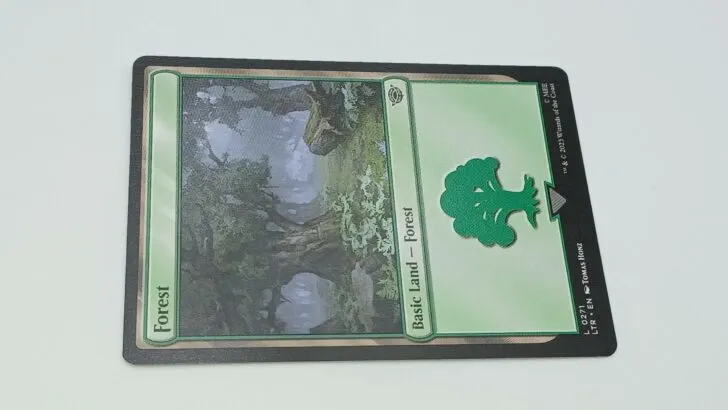
You will usually tap a card for one of three actions.
- Using a land card for its mana.
- Attacking with a creature card.
- Activating an ability that has the tapping symbol as part of its cost.
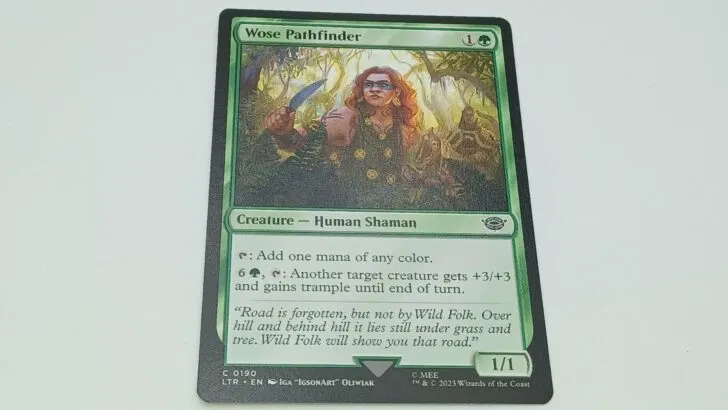
First Main Phase
In this phase you can choose to play a land card from your hand. There is no cost for playing a land card. You may only play one land card from your hand each turn. When you play a land card you will place it in the battlefield vertically (untapped).
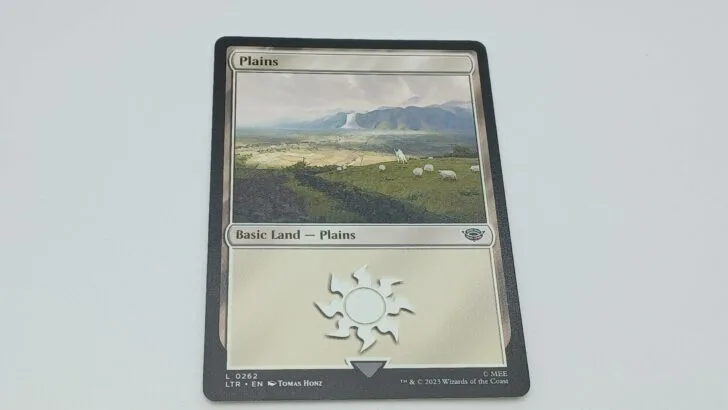
During the first main phase you can also play any number of other cards from your hand. The only restriction is that you have enough mana in front of you to pay their cost. See the Casting Spells section below for more details on how to play cards.
During this phase you can also activate abilities that you can use during this phase.
Casting Spells
To play any card in Magic: The Gathering The Lord of the Rings Tales of Middle-Earth outside of land cards, you must pay a cost.
In the top right corner of each card is its mana cost. To play a card you need to pay its mana cost. You will pay a card’s mana cost by tapping land and other permanent cards that provide the mana that you need.
There are two different types of mana costs.
- A number inside a gray circle can be payed with any type of mana.
- Any symbols after the gray circle need to be paid specifically with that type of mana.
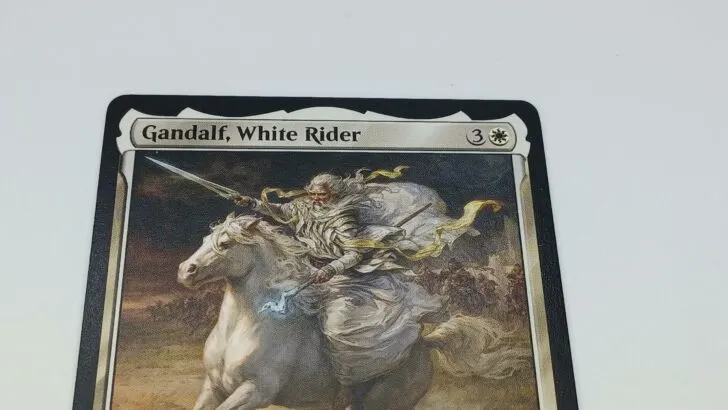
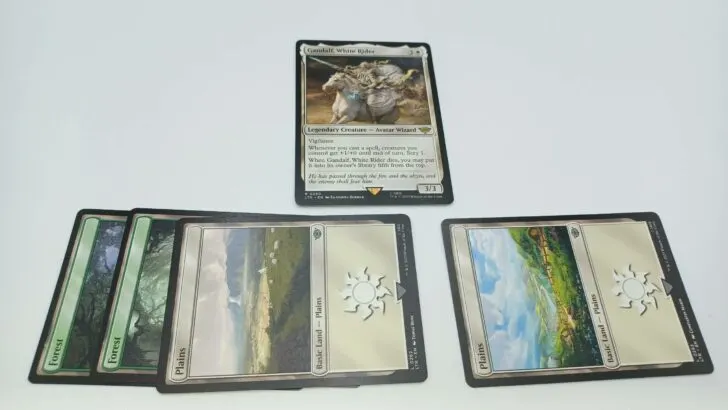
Once you have cast a spell/played a card, you will handle the card based on what type of card it is.
If you played a instant or sorcery card, you will follow its instructions immediately. You will then put the card in your graveyard.
If you play a creature, artifact, or enchantment; you will place them in the battlefield.
Combat Phase
After you finish playing cards and using abilities during the first main phase, you will move onto the combat phase.
Combat begins with the current player deciding which of their characters they want to use to attack. You can attack with as many or as few (including none) of your creatures. The only rule is that you can only use creatures that are currently untapped. You also can’t attack with a creature on the turn that you first summoned it. You will tell the other player which creatures you are going to attack with and tap the corresponding cards to show that you are using them to attack.
The other player then decides whether they want to block any of the upcoming attacks. The attacking player begins by attacking the other player directly. If the defending player decides not to block the attack, the attacking player deals damage directly to their opponent’s life total.
The blocking player can use as many of their creatures as they want. They can only use untapped creatures. After choosing a creature(s) to defend, the defender chooses which creature each defending creature will block. You can use multiple creatures to defend against one attacking creature.
The players then determine what happens in combat.
When you have completed all combat, play moves to the second main phase.
Determining the Outcome of Combat
All combat is done simultaneously. Both the attacking and defending creatures will deal damage and block attacks.
In the bottom right corner of each card are two numbers separated by a / symbol. The first number is the creatures power (attack strength). The second number is the creature’s toughness (blocking strength).
Directly Attacking the Other Player
If an attacking creature is not blocked, it will directly attack the other player’s life total. Reduce their life total by the power (attack strength) of the attacking creature.
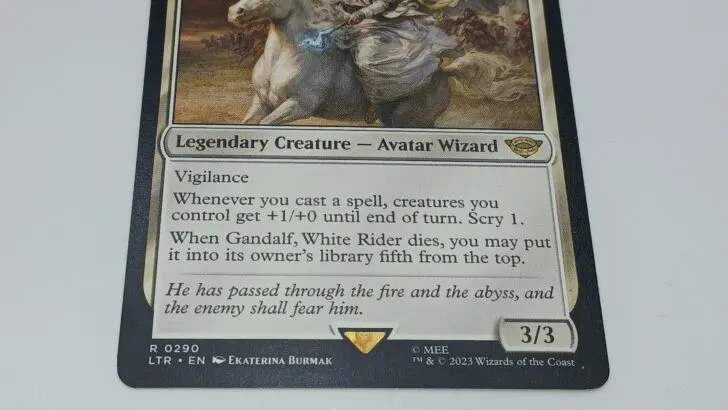
Attacking a Defending Creature
If an attacking creature is blocked (by one or more creatures), the attacking and defending creature(s) both attack one another at the same time. Each creature deals damage to their opponent based on their power (attack strength).
Should a creature receive damage equal to or higher than its toughness (blocking strength), they are destroyed. Place the card in its owner’s graveyard.
If a creature is dealt damage less than its toughness, it will lose health equal to the power of the other creature(s). Another creature or spell/ability can deal the remaining damage needed to destroy the creature. If a creature is not destroyed by the end of the current turn, any lost health is returned to the creature.
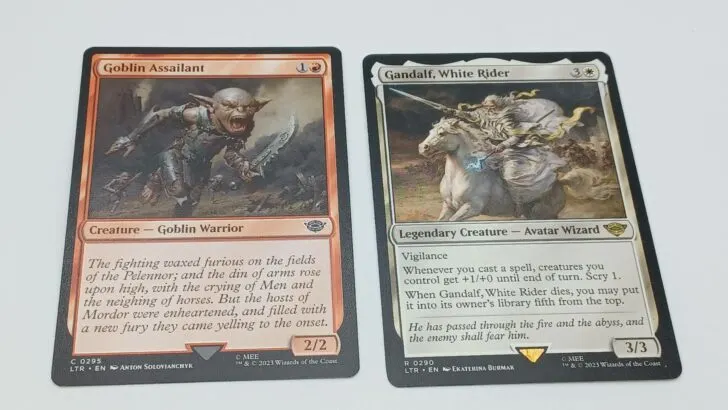
If an attacking creature is blocked by multiple creatures, the attacking player chooses the order that the defending creatures block. Should the attacking creature do more damage than the first defending creatures toughness, it will destroy that creature. You will apply any remaining attack power to the next defending creature. This continues until you apply all of the attack power of the attacking creature to a defending creature or there are no other defending creatures.
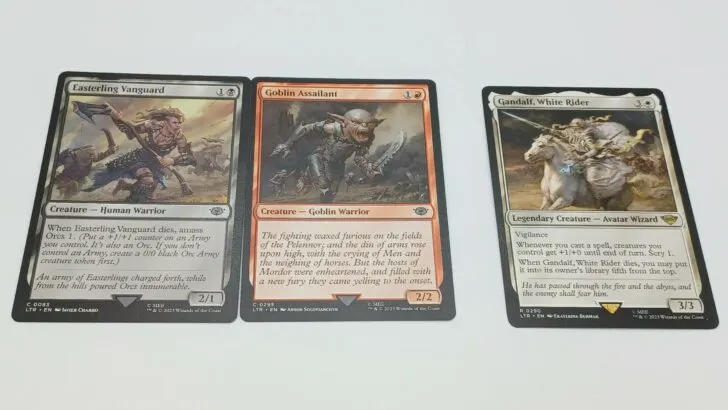
Second Main Phase
The second main phase is played in the same way as the first main phase.
You can play any type of card as long as you pay the corresponding mana cost. You can also activate any abilities that can be activated during this phase.
If you didn’t play a land during your first main phase, you can choose to play one land card during the Second Main Phase.
Ending Phase
During the ending phase you can use any abilities that trigger “at the beginning of your end step”.
Next count the number of cards that you have in your hand. If you have more than seven cards in your hand, you will discard cards to your graveyard until you only have seven cards left in your hand.
Remove all damage tokens applied to creatures during the turn.
Finally apply all “until end of turn” effects.
Winning Magic: The Gathering The Lord of the Rings Tales of Middle-Earth
You can win Magic: The Gathering The Lord of the Rings Tales of Middle-Earth in two different ways.
The first way to defeat your opponent is to reduce their life total to zero. If you succeed at reducing their life total to zero, you win the game.
Otherwise you can win the game if the other player has to draw a card from their library and they have no cards left to draw.
Magic: The Gathering The Lord of the Rings Tales of Middle-Earth FAQs
If you have any questions about how to play Magic: The Gathering The Lord of the Rings Tales of Middle-Earth, leave a comment below on this post. I will try to answer any questions asked as best and as quickly as possible.
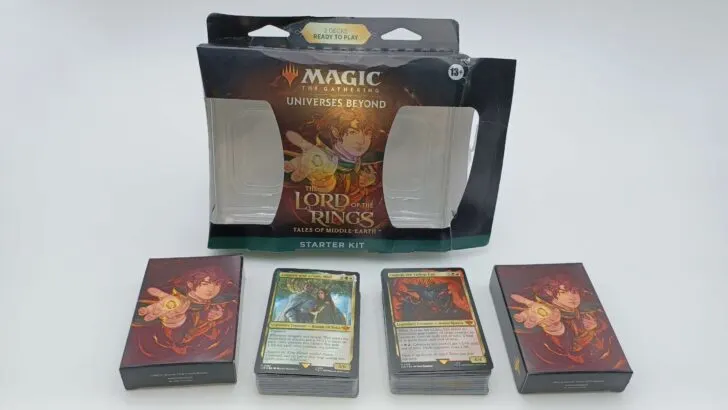
Magic: The Gathering The Lord of the Rings Tales of Middle-Earth Components
Listed below are the components for the starter kit. The starter kit includes two pre-assembled decks and instructions for how to play the game.
Deck 1 – Aragorn and Arwen, Wed
- Aragorn and Arwen, Wed (Foil)
- Frodo, Determined Hero
- Gandalf, White Rider
- Galadriel, Gift-Giver
- Bilbo’s Ring
- 3x – Knight of the Keep
- Westfold Rider
- East-Mark Cavalier
- Eastfarthing Farmer
- 2x – Protector of Gondor
- Dúnedain Blade
- Second Breakfast
- Rosie Cotton of South Lane
- 2x – Banishing Light
- Landroval, Horizon Witness
- You Cannot Pass!
- 2x – Mushroom Watchdogs
- 2x – Wose Pathfinder
- 2x – Bag End Porter
- Generous Ent
- 2x – Many Partings
- Galadhrim Bow
- Meriadoc Brandybuck
- Peregrin Took
- Stew the Coneys
- Butterbur, Bree Innkeeper
- 2x – Shire Terrace
- 2x – Graypelt Refuge
- 11x – Forest
- 11x – Plains
- 2x – Food
- Turn Order Card
Deck 2 – Sauron
- Sauron, the Lidless Eye (Foil)
- Gollum, Scheming Guide
- Witch-king, Bringer of Ruin
- Fires of Mount Doom
- The Balrog, Flame of Udûn
- 3x – Goblin Assailant
- 2x – Easterling Vanguard
- 2x – Feed the Swarm
- 2x – Dunland Crebain
- 2x – Mordor Trebuchet
- Snarling Warg
- Shelob’s Ambush
- Nasty End
- Gothmog, Morgul Lieutenant
- Voracious Fell Beast
- Swarming of Moria
- 2x – Olag-hai Crusher
- Oliphaunt
- Cast in the Fire
- Fire of Orthanc
- Goblin Fireleaper
- Grishnákh, Brash Instigator
- 2x – Foray of Orcs
- Mauhúr, Uruk-hai Captain
- Uglúk of the White Hand
- Mind Stone
- 4x – Evolving Wilds
- 11x – Swamp
- 11x – Mountain
- 2x – Food
- Turn Order Card
Year: 2023 | Publisher: Wizards of the Coast | Designer: Richard Garfield
Genres: Collectible Card Game
Ages: 13+ | Number of Players: 2-8 | Length of Game: 20 minutes
Difficulty: Light-Moderate | Strategy: Moderate | Luck: Light-Moderate
Where to Purchase: Amazon, eBay Any purchases made through these links (including other products) help keep Geeky Hobbies running. Thank you for your support.
For more board and card game how to plays/rules and reviews, check out our complete alphabetical list of board game posts.

